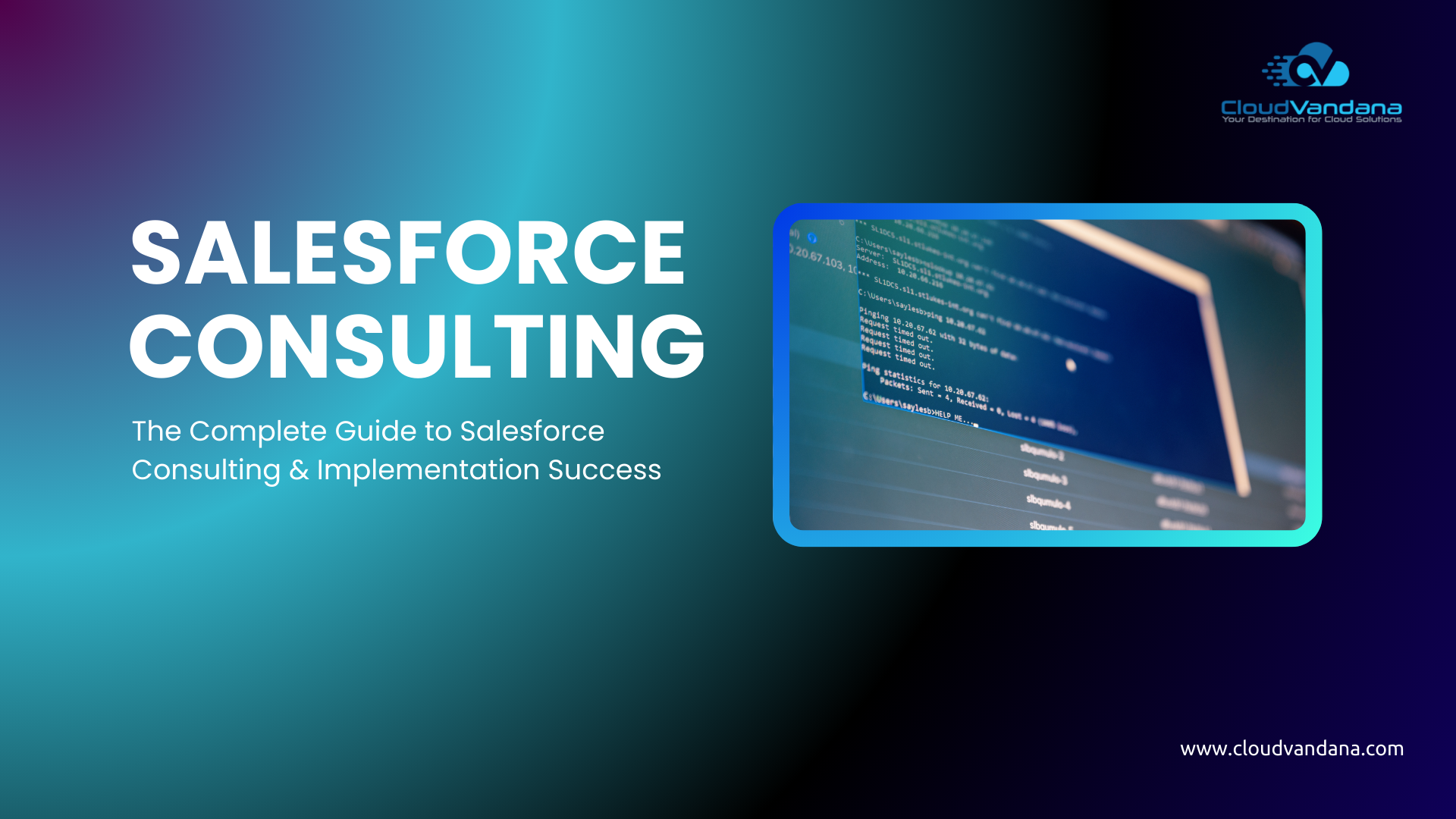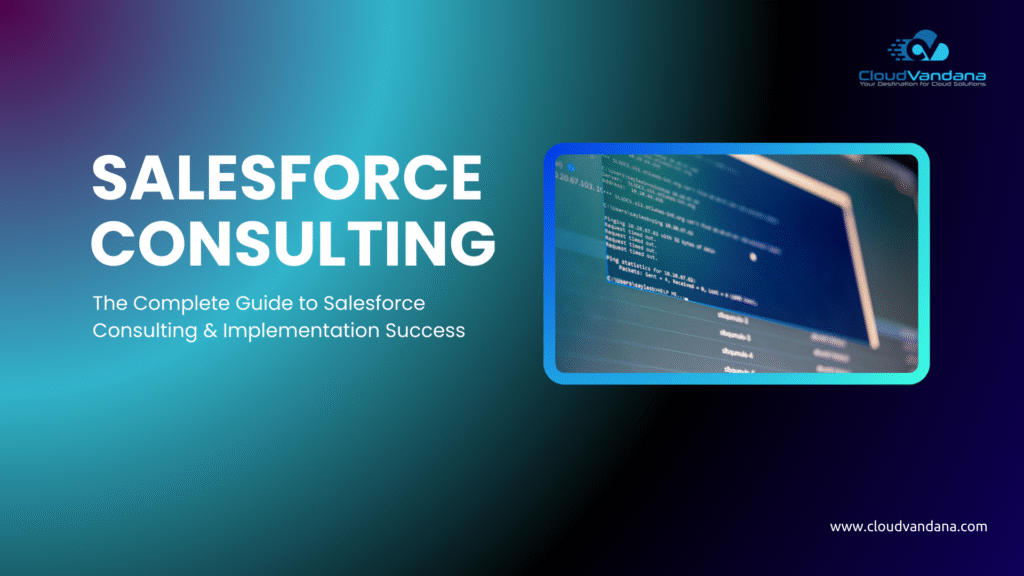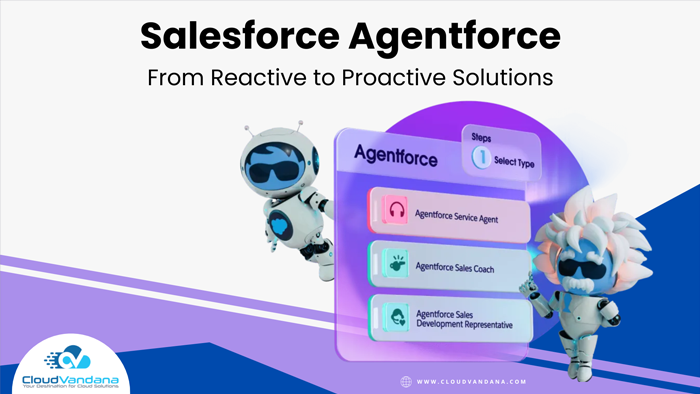Discover how to achieve Salesforce consulting and implementation success. Explore strategies, common pitfalls, and CloudVandana’s proven expertise.
Introduction: Why Salesforce Consulting Matters Today
In today’s hyper-competitive environment, customer experience is the ultimate differentiator. Salesforce has emerged as the most powerful platform to deliver this experience—providing companies with a unified system to manage sales, service, marketing, commerce, analytics, and more. Yet, despite its dominance, many organizations struggle to achieve true success with Salesforce.
Why? Because Salesforce is not just an out-of-the-box tool. It’s a digital transformation platform that requires vision, planning, and deep technical expertise. Without these, businesses risk underutilizing it, leading to wasted investment and frustrated teams.
This is where Salesforce consulting becomes indispensable. A skilled consulting partner acts as both guide and architect—helping organizations design, implement, and scale Salesforce in a way that aligns with business strategy.
As Marc Benioff, Salesforce’s co-founder and CEO, has often said: “Speed is the new currency of business.” Salesforce consulting ensures organizations don’t just adopt Salesforce, but do so quickly, intelligently, and sustainably.
The Growing Complexity of Salesforce Ecosystem
Evolution from CRM to Full Business Platform
Salesforce began in 1999 as a simple CRM delivered over the cloud—a radical departure from on-premise software at the time. Over two decades, it has evolved into a vast ecosystem that touches every corner of an enterprise. Today, Salesforce includes:
- Sales Cloud for managing leads, opportunities, and pipelines.
- Service Cloud for omnichannel customer support.
- Marketing Cloud for automation and campaign orchestration.
- Commerce Cloud for digital storefronts and e-commerce.
- Experience Cloud for building portals and communities.
- MuleSoft for API-led integration across systems.
- Tableau for advanced analytics and visualization.
- Slack for team collaboration integrated with CRM data.
This expansion means Salesforce is no longer a “tool” but a business operating system. The breadth of its capabilities is what makes it so powerful—and so complex to implement.
Why Businesses Struggle with DIY Implementations
Many organizations attempt to implement Salesforce internally, assuming it’s simply a matter of licensing and setup. But Salesforce is more like an empty canvas—it provides building blocks, not finished art. Missteps often include:
- Misalignment between Salesforce capabilities and business processes.
- Poor data migration strategies that lead to inaccurate reports.
- Lack of integration with ERP, HR, or marketing systems.
- Over-customization that creates unnecessary complexity.
- Limited user adoption because employees don’t see value.
Without expert guidance, Salesforce projects often end up over budget, behind schedule, or underutilized. Consulting partners prevent these outcomes.
What Is Salesforce Consulting?
Definition and Scope
Salesforce consulting is a specialized service that helps businesses maximize Salesforce’s potential by aligning the platform with organizational strategy, processes, and goals. It includes planning, implementation, customization, integration, training, and ongoing optimization.
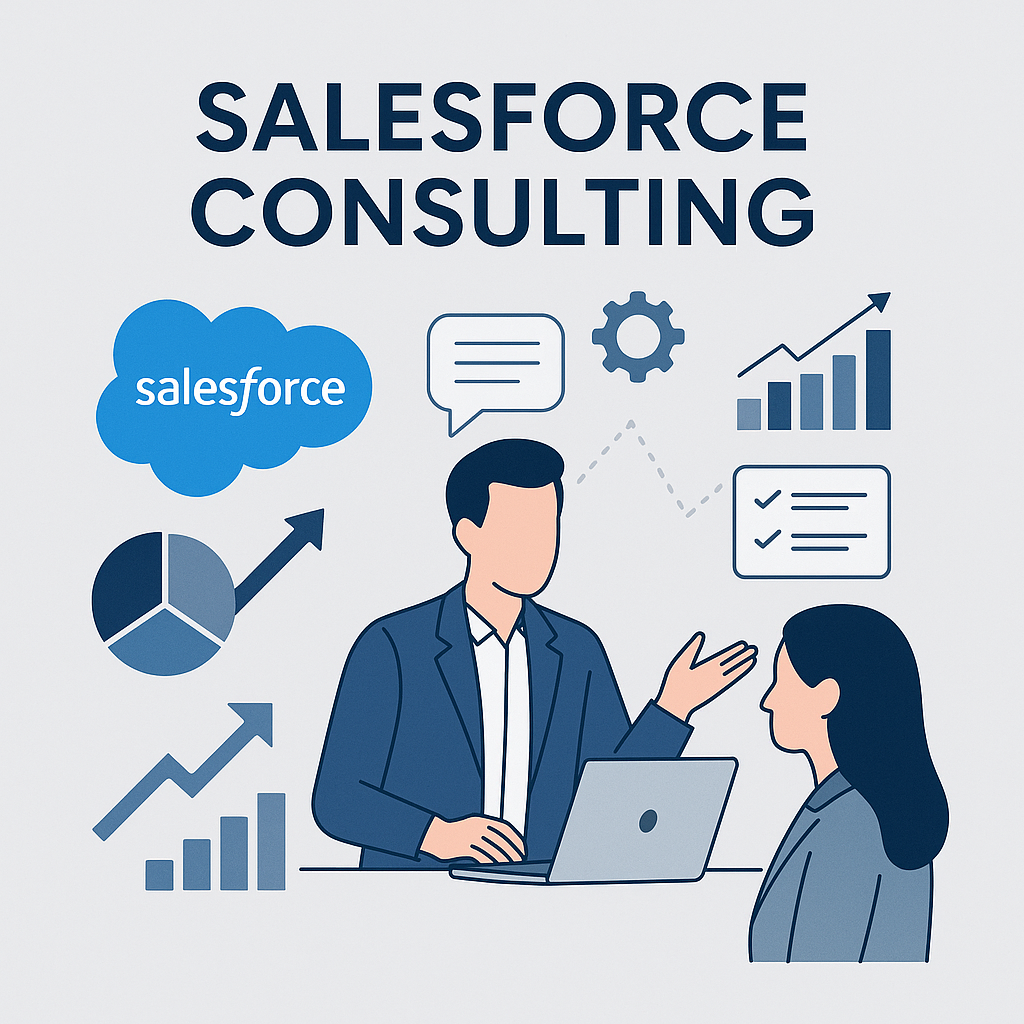
In essence, Salesforce consulting turns technology into a growth enabler.
Roles of a Salesforce Consultant
A Salesforce consultant wears many hats:
- Strategist: Aligns Salesforce capabilities with corporate objectives.
- Architect: Designs scalable, future-ready system blueprints.
- Technologist: Builds custom apps, automation, and integrations.
- Trainer & Change Agent: Ensures employees embrace Salesforce.
The consultant’s value lies in combining technical depth with business acumen.
Key Benefits of Salesforce Consulting Services
- Accelerated Implementation – A consultant avoids trial-and-error approaches, ensuring faster time to value.
- Risk Mitigation – By following best practices, consultants prevent costly missteps.
- Maximizing ROI – Consultants ensure Salesforce is aligned with KPIs, so companies extract full value from their investment.
- Future-Proofing – A scalable design prevents technical debt and ensures smooth upgrades.
- Better User Adoption – Consultants implement effective training and support mechanisms.
Understanding Salesforce Implementation
What Implementation Really Means
Salesforce implementation is not merely “installing software.” It involves transforming how a business engages with its customers, employees, and partners. It requires aligning processes with technology, cleaning and migrating data, and embedding Salesforce into daily workflows.
The Strategic vs. Technical Divide
Some organizations see implementation as purely technical—setting up workflows, fields, and dashboards. But without strategic alignment, the implementation lacks impact. True success is found where business strategy meets technical execution.
Phases of a Successful Salesforce Implementation
A Salesforce implementation is a journey that transforms how an organization operates. It’s not just about deploying software; it’s about aligning people, processes, and technology to deliver lasting business value. A successful implementation typically follows a structured sequence of phases, each building upon the last to ensure a smooth rollout and strong adoption.
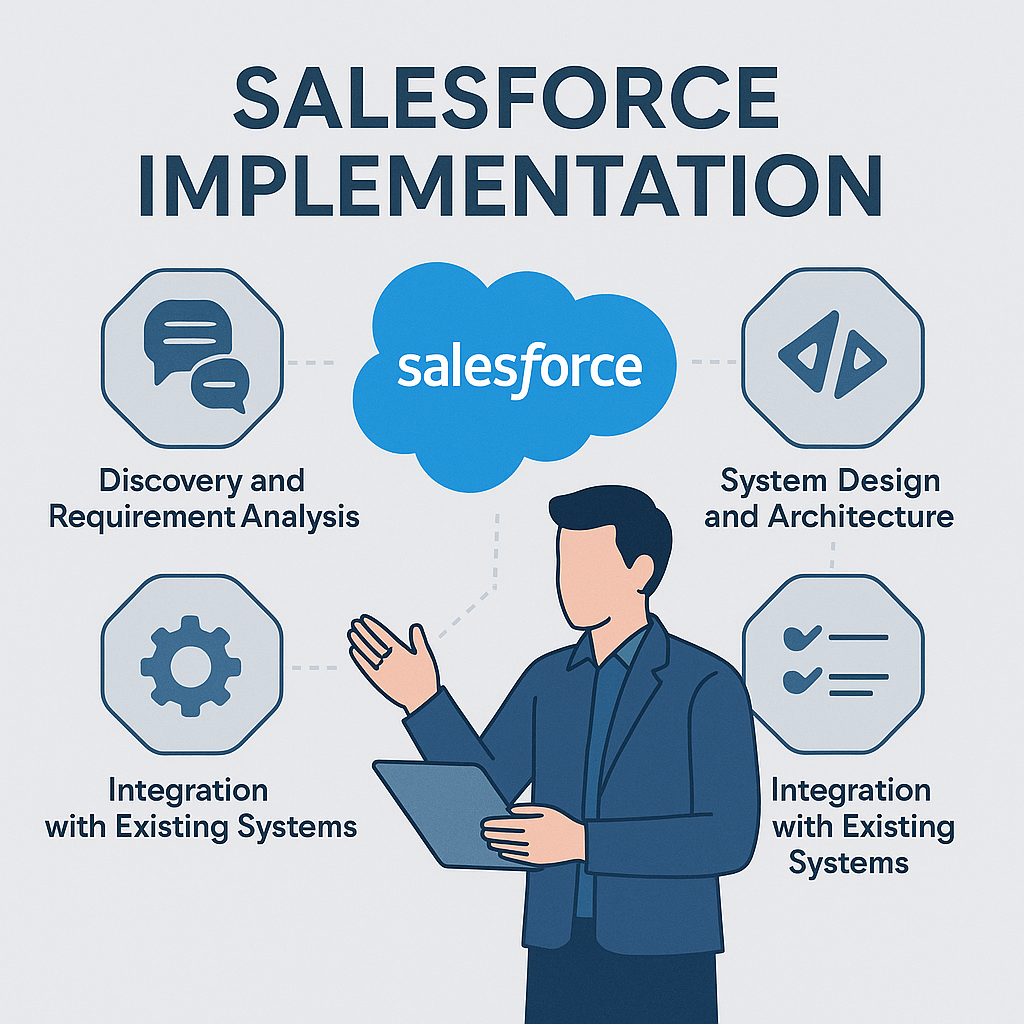
1. Discovery and Requirement Analysis
Every successful Salesforce project begins with discovery. In this phase, consultants work closely with stakeholders to understand business objectives, challenges, and existing workflows.
- Stakeholder Workshops: Interactive sessions capture insights from sales, service, marketing, and operations teams. These workshops ensure that the system design reflects the needs of actual users, not just leadership directives.
- Workflow Mapping: Current processes are analyzed to identify bottlenecks, redundancies, and inefficiencies. Mapping these workflows highlights where Salesforce automation can add the most value.
The outcome of this phase is a clear requirements document—a blueprint that defines the “must-haves” and “nice-to-haves” for the project.
2. System Design and Architecture
Once requirements are defined, architects translate them into a scalable design. This is where business goals meet technical execution.
- Creating Scalable Data Models: Consultants design a schema that can handle current needs while accommodating future growth. This includes defining objects, relationships, and fields with precision.
- Configuration vs. Customization Choices: Not every requirement needs custom code. Experienced consultants evaluate when to use Salesforce’s point-and-click tools (like Flows and App Builder) versus when to introduce Apex or Lightning Web Components. The goal is to balance flexibility with maintainability.
This phase ensures the system is designed not only to solve today’s problems but also to support tomorrow’s ambitions.
3. Customization and Development
With the architecture finalized, the system moves into the build phase.
- Using Apex, Lightning Web Components, or Third-Party Apps: Developers extend Salesforce functionality to meet unique needs. This might include custom automation for lead routing, Lightning Web Components for tailored user interfaces, or third-party AppExchange solutions for specialized functions like e-signature or advanced analytics.
Customization brings Salesforce to life, making it feel native to the organization’s processes.
4. Integration with Existing Systems
No system exists in isolation. Salesforce must work in harmony with the broader enterprise ecosystem.
- Connecting ERP, HR, Marketing, and Financial Systems: Common integrations include syncing Salesforce with ERP for order management, HR systems for employee data, or marketing automation platforms like Pardot or HubSpot for campaign management. Middleware solutions such as MuleSoft or Boomi often facilitate these connections.
Integration creates the much-coveted 360° customer view—where every department has access to the same unified data.
5. Testing and Validation
Before Salesforce goes live, it must be thoroughly tested.
- User Acceptance Testing (UAT): End users validate that the system behaves as expected in real-world scenarios. This step ensures workflows, reports, and dashboards deliver the intended value.
- Functional and Performance Testing: Consultants check for bugs, performance bottlenecks, and data inconsistencies.
Testing minimizes the risk of disruptions post-deployment and builds user confidence in the system.
6. Training and Change Management
Technology adoption depends on people, not just systems. This phase focuses on preparing employees to embrace Salesforce.
- Equipping Users with Knowledge and Support: Tailored training sessions—both role-based and scenario-driven—help employees see how Salesforce makes their work easier. Documentation, e-learning modules, and help desks provide ongoing support.
- Change Management: Communication strategies explain why Salesforce is being implemented, what benefits it brings, and how it impacts employees’ daily tasks. This human-centered approach minimizes resistance and builds enthusiasm.
7. Deployment and Ongoing Support
With everything tested and users trained, Salesforce is ready for launch. But deployment is not the end—it’s the beginning of continuous improvement.
- Monitoring Adoption: Usage metrics such as login frequency, record updates, and dashboard views are tracked to measure engagement.
- Iterating Improvements: Feedback loops allow consultants to fine-tune configurations, add enhancements, and introduce new features over time.
- Ongoing Support: Managed services provide regular system audits, release management (for Salesforce’s three annual updates), and proactive issue resolution.
This phase ensures Salesforce doesn’t remain static but evolves with the business.
Common Pitfalls in Salesforce Implementation
Even with the best intentions, Salesforce projects can falter if certain risks are overlooked. Understanding these pitfalls helps organizations prepare proactively and avoid costly setbacks.
1. Over-Customization: Unnecessary Code Leads to High Maintenance
Salesforce provides robust configuration tools—flows, validation rules, page layouts—that often solve most business needs without code. However, many implementations fall into the trap of over-customization by writing excessive Apex code or creating too many Lightning Web Components.
While custom code can provide flexibility, it also introduces long-term challenges:
- Higher maintenance costs.
- Compatibility issues during Salesforce’s seasonal updates.
- Slower system performance.
A “configure-first, customize-second” approach ensures agility while keeping technical debt minimal.
2. Lack of User Adoption: If Users Bypass Salesforce, Data Loses Accuracy
Even the most technically sound Salesforce implementation fails if employees do not embrace it. When users bypass Salesforce and continue working in spreadsheets or offline tools, the platform’s data becomes fragmented and unreliable.
The consequences include:
- Sales forecasts that don’t reflect reality.
- Inaccurate reports for leadership.
- Frustrated teams juggling multiple systems.
Driving adoption requires comprehensive training, role-specific dashboards, and ongoing support. Employees must see Salesforce as a productivity booster, not as extra work.
3. Ignoring Data Quality: Poor Migration Creates Bad Insights
Data is the lifeblood of CRM, but poor-quality data can cripple Salesforce. If legacy systems are migrated without cleansing, duplicates, missing fields, and inaccuracies get embedded into the new platform.
This leads to:
- Faulty analytics and KPIs.
- Inefficient marketing campaigns.
- Low trust in reports among executives.
Strong data governance policies—including deduplication, validation rules, and regular audits—are essential for long-term success. As the saying goes: “Garbage in, garbage out.”
4. Underestimating Change Management: Employees Resist Change Without Proper Guidance
Technology alone doesn’t drive transformation—people do. One of the most underestimated pitfalls is neglecting change management. Employees accustomed to legacy systems may resist Salesforce adoption, perceiving it as disruptive or unnecessary.
Without a clear strategy for change management, organizations face:
- Passive resistance or outright rejection from users.
- Slow adoption rates.
- Projects that deliver little return on investment.
Effective change management includes transparent communication, leadership buy-in, role-based training, and feedback loops. Employees must feel engaged, informed, and supported throughout the journey.
Avoiding these pitfalls requires foresight, planning, and ongoing support. Organizations that recognize and address these challenges early transform Salesforce from a software platform into a genuine growth engine.
The Role of Data in Salesforce Success
Importance of Data Migration Strategy
Migrating from legacy CRMs or spreadsheets is a delicate process. A clear strategy prevents data corruption, duplication, and gaps.
Ensuring Data Integrity
Validation rules, duplicate management, and standardized formats ensure data remains reliable.
Data Governance for Long-Term Scalability
Appointing data stewards and creating governance policies is essential for growth.
Customization vs. Configuration: Finding the Balance
When to Configure
Use Salesforce’s native tools—Flows, Validation Rules, App Builder—when needs are straightforward.
When to Customize
Resort to Apex code, APIs, or Lightning Web Components only when out-of-the-box options fall short.
Avoiding Technical Debt
Balance is critical. Over-engineering today can cripple agility tomorrow.
Integrations: Connecting Salesforce with the Enterprise
APIs and Middleware Solutions
MuleSoft, Informatica, and Boomi enable complex integrations without heavy code.
Common Integration Scenarios
- ERP for financial alignment.
- Marketing Automation for lead nurturing.
- HR Systems for employee onboarding.
Integrations create the 360-degree customer view Salesforce promises.
User Adoption as the Cornerstone of Success
- Building a Training Culture: Continuous learning programs increase comfort.
- Incentivizing Usage: Recognition, leaderboards, and gamification drive engagement.
- Continuous Feedback Loops: Users must feel heard to sustain adoption.
Change Management in Salesforce Projects
Technology projects often stumble not because the system is poorly designed, but because people resist change. Salesforce, by its nature, reshapes how teams work. It alters sales routines, customer service interactions, and reporting structures. If this shift is not managed effectively, adoption suffers—and the investment in Salesforce underdelivers.
The Human Side of CRM Adoption
Employees are rarely resistant to technology itself; they resist the disruption that comes with it. When Salesforce feels like a tool imposed from above, without explanation, skepticism grows. Salespeople may cling to spreadsheets, service teams may rely on legacy tools, and managers may question reports that don’t align with their familiar workflows.
The antidote is purpose-driven leadership. Leaders must articulate the “why” behind Salesforce: why the change is happening, how it benefits the company, and—most importantly—how it makes employees’ lives easier.
Examples of the “why” that resonates with teams include:
- For sales teams: “Salesforce eliminates double data entry so you can spend more time closing deals.”
- For service teams: “You’ll have a 360° customer view, reducing time spent searching for past interactions.”
- For executives: “Reliable dashboards allow faster, better-informed decisions.”
When employees see Salesforce as a value creator rather than an added burden, resistance transforms into acceptance.
Communication Frameworks That Work
Effective change management requires clear, consistent, and multi-layered communication. Successful Salesforce projects often apply three proven frameworks:
- Regular Updates
- Progress updates and small wins should be shared frequently, not just at go-live.
- Transparency reduces anxiety and builds trust.
- Progress updates and small wins should be shared frequently, not just at go-live.
- Leadership Champions
- Executives and managers must lead by example. When leadership uses Salesforce dashboards in meetings, it signals that adoption is non-negotiable.
- Champions across departments serve as advocates, addressing concerns and encouraging peers.
- Executives and managers must lead by example. When leadership uses Salesforce dashboards in meetings, it signals that adoption is non-negotiable.
- Storytelling About Success
- Sharing real stories of employees who have achieved faster sales cycles, quicker resolutions, or better collaboration through Salesforce creates inspiration.
- Stories personalize the benefits far more effectively than technical demos.
- Sharing real stories of employees who have achieved faster sales cycles, quicker resolutions, or better collaboration through Salesforce creates inspiration.
As John Kotter, a renowned change management expert, once said: “Behavior change happens mostly by speaking to people’s feelings.” Communication frameworks grounded in empathy and storytelling do exactly that.
Selecting the Right Salesforce Consulting Partner
Choosing the right Salesforce consulting partner can be the difference between a smooth, value-driven implementation and a frustrating, underwhelming experience. With hundreds of certified partners available worldwide, organizations must carefully evaluate who is best positioned to guide their Salesforce journey.
Criteria to Evaluate Partners
When assessing potential partners, look beyond flashy sales pitches. The right consultant demonstrates:
- Certifications: Salesforce-certified professionals prove technical expertise in core clouds (Sales, Service, Marketing) and specialties like integration or analytics.
- References: A partner should be able to provide case studies and client testimonials demonstrating successful outcomes.
- Methodologies: Implementation frameworks matter—structured, repeatable methodologies (like Agile or hybrid approaches) ensure projects stay on track.
A trusted partner will also take time to understand your business rather than pushing a one-size-fits-all solution.
Importance of Industry Expertise
Every industry has its nuances. Healthcare organizations must comply with HIPAA and data security regulations, financial institutions require strong audit trails, and retail companies prioritize omnichannel customer engagement.
An experienced consulting partner brings industry-specific insights that accelerate implementation and reduce risks. For example, a partner familiar with financial services will know how to configure Salesforce for compliance reporting, while a healthcare-focused partner will design patient engagement workflows that align with regulatory standards.
CloudVandana, as a global Salesforce consulting partner, has demonstrated this cross-industry expertise—helping clients in sectors such as technology, retail, and services tailor Salesforce to their unique needs.
Certifications and Proven Track Record
Salesforce evaluates its partners using a tiered system—Registered, Ridge, Crest, and Summit. Partners who achieve Crest or Summit status have proven themselves through certifications, customer success stories, and consistent delivery quality.
Working with such partners provides assurance of maturity, reliability, and a tested approach to complex implementations.
CloudVandana, with its certified Salesforce experts and a portfolio of successful implementations across industries, exemplifies what businesses should seek in a consulting partner: a combination of technical mastery, business acumen, and a client-first philosophy.
In summary, selecting the right Salesforce consulting partner means looking for more than technical skills—it requires certifications, industry experience, proven methodologies, and a track record of measurable impact. With partners like CloudVandana, businesses can confidently navigate their Salesforce journey and unlock the platform’s full potential.
Case Study: A Global Enterprise Transformation with Salesforce
Background: A Fortune 500 retail giant faced disconnected customer touchpoints.
Challenges: Siloed sales and service teams, fragmented data, inconsistent customer journeys.
Solution: Salesforce Service Cloud, Marketing Cloud, and MuleSoft integration led by a top consulting partner.
Results:
- 45% faster case resolution.
- Unified 360° customer view.
- 30% increase in upselling revenue.
Insights from Salesforce Experts
- Marc Benioff: “The business of business is improving the state of the world.”
- Parker Harris: “Innovation is not just features, it’s about enabling transformation.”
- Clara Shih (Salesforce AI lead): “AI won’t replace humans, but humans with AI will replace those without it.”
These voices highlight why consulting bridges innovation with execution.
Measuring Salesforce Implementation Success
- Adoption Metrics: Login frequency, dashboard views, automation usage.
- Business KPIs: Revenue acceleration, churn reduction, service SLAs.
- Customer Experience Improvements: NPS, customer satisfaction scores, engagement.
Ongoing Support and Managed Services
Why Post-Implementation Support Matters
Salesforce evolves with three releases every year. Continuous support ensures businesses stay updated.
Continuous Optimization
Managed services include enhancements, bug fixes, new automation, and training refreshers.
Future Trends in Salesforce Consulting
- AI and Predictive Analytics: Einstein GPT will reshape forecasting.
- Industry-Specific Solutions: Financial Services Cloud, Health Cloud, and Government Cloud are on the rise.
- Low-Code/No-Code Evolution: Empowering citizen developers reduces dependency on IT.
Best Practices for Salesforce Consulting & Implementation
- Align IT initiatives with business goals.
- Start small—roll out in phases, learn, and scale.
- Maintain a culture of continuous improvement.
- Focus equally on people and technology.
Conclusion: Turning Salesforce into a Strategic Growth Engine
Salesforce is not merely a software—it is an organizational enabler. With the right consulting partner, businesses can transform Salesforce into a strategic growth engine that drives customer loyalty, operational excellence, and innovation.
As Benioff reminds us: “You must always be able to predict what’s next and then have the flexibility to evolve.” Consulting ensures businesses achieve exactly that—staying agile, resilient, and future-ready.
Frequently Asked Questions (FAQs)
1. What is Salesforce consulting, and why do businesses need it?
Salesforce consulting helps organizations design, implement, and optimize Salesforce to align with business goals. Consultants ensure that the platform is customized correctly, integrated with existing systems, and adopted by users—maximizing ROI and minimizing risks.
2. How long does a typical Salesforce implementation take?
The timeline depends on complexity. A basic implementation can take 6–12 weeks, while enterprise-level projects with integrations, custom development, and multiple clouds can take 6–12 months. Partnering with experienced consultants accelerates delivery.
3. What are the costs associated with Salesforce consulting?
Costs vary based on scope, industry, and level of customization. Consulting partners usually charge project-based fees or offer managed services models. While it is an investment, the long-term ROI—through efficiency, better insights, and growth—far outweighs initial costs.
4. How do I choose the right Salesforce consulting partner?
Look for certifications, industry expertise, a proven track record, and references. Crest or Summit-level partners like CloudVandana signal maturity, credibility, and consistent delivery excellence.
5. What are the most common mistakes in Salesforce implementation?
Pitfalls include over-customization, lack of user adoption, ignoring data quality, and underestimating change management. Avoiding these requires strong governance, effective training, and a thoughtful rollout plan.
6. How can we ensure high user adoption of Salesforce?
Adoption depends on change management. Role-based training, leadership advocacy, clear communication, and incentives encourage employees to embrace Salesforce as a productivity enhancer.
7. What role does data quality play in Salesforce success?
Data is the foundation of Salesforce. Poor data migration or inconsistent practices undermine reporting and decision-making. Data cleansing, deduplication, and governance frameworks ensure long-term success.
8. Should we configure or customize Salesforce?
Start with configuration (using Salesforce’s native tools) whenever possible. Use customization (Apex, Lightning Web Components, or third-party apps) only when business needs cannot be met with configuration. This prevents technical debt.
9. How does Salesforce integrate with other business systems?
Salesforce integrates with ERP, HR, financial, and marketing systems via APIs and middleware (e.g., MuleSoft, Boomi). These integrations create a unified 360° customer view across the enterprise.
10. What ongoing support is needed after Salesforce go-live?
Salesforce releases updates three times a year. Ongoing support includes training refreshers, system audits, feature enhancements, and managed services. Continuous optimization ensures Salesforce evolves with the business.
11. What KPIs should we track to measure Salesforce success?
Key metrics include user adoption rates, pipeline velocity, case resolution times, revenue growth, and customer satisfaction (NPS/CSAT). These show whether Salesforce is delivering business value.
12. Why choose CloudVandana as a Salesforce consulting partner?
CloudVandana combines certified Salesforce expertise with cross-industry experience and a proven track record. From implementation and integration to ongoing support, CloudVandana helps businesses unlock Salesforce’s full potential—turning it into a true growth engine.

Atul Gupta is CloudVandana’s founder and an 8X Salesforce Certified Professional who works with globally situated businesses to create Custom Salesforce Solutions.
Atul Gupta, a dynamic leader, directs CloudVandana’s Implementation Team, Analytics, and IT functions, ensuring seamless operations and innovative solutions.



